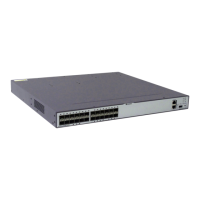[SwitchD] ip route-static 200.0.0.0 8 null 0
[SwitchD] ospf
[SwitchD-ospf-1] import-route static type 1
[SwitchD-ospf-1] quit
# Display the ABR or ASBR of SwitchC.
[SwitchC] display ospf abr-asbr
OSPF Process 1 with Router ID 3.3.3.3
Routing Table to ABR and ASBR
Type Destination Area Cost Nexthop RtType
Intra-area 1.1.1.1 0.0.0.1 1 192.168.1.1 ABR
Inter-area 4.4.4.4 0.0.0.1 3 192.168.1.1 ASBR
# Check the routing table of an OSPF process of SwitchC.
[SwitchC] display ospf routing
OSPF Process 1 with Router ID 3.3.3.3
Routing Tables
Routing for Network
Destination Cost Type NextHop AdvRouter Area
172.16.1.0/24 1 Transit 172.16.1.1 3.3.3.3 0.0.0.1
172.17.1.0/24 4 Inter-area 192.168.1.1 1.1.1.1 0.0.0.1
192.168.0.0/24 2 Inter-area 192.168.1.1 1.1.1.1 0.0.0.1
192.168.1.0/24 1 Transit 192.168.1.2 3.3.3.3 0.0.0.1
192.168.2.0/24 3 Inter-area 192.168.1.1 1.1.1.1 0.0.0.1
Routing for ASEs
Destination Cost Type Tag NextHop AdvRouter
200.0.0.0/8 4 Type1 1 192.168.1.1 4.4.4.4
Total Nets: 6
Intra Area: 2 Inter Area: 3 ASE: 1 NSSA: 0
If the area where SwitchC resides is the common area, you can view that AS external routes
exist in the routing table.
3. Configure Area 1 as a stub area.
# Configure SwitchA.
[SwitchA] ospf
[SwitchA-ospf-1] area 1
[SwitchA-ospf-1-area-0.0.0.1] stub
[SwitchA-ospf-1-area-0.0.0.1] quit
[SwitchA-ospf-1] quit
# Configure SwitchC.
[SwitchC] ospf
[SwitchC-ospf-1] area 1
[SwitchC-ospf-1-area-0.0.0.1] stub
[SwitchC-ospf-1-area-0.0.0.1] quit
[SwitchC-ospf-1] quit
# Configure SwitchE.
[SwitchE] ospf
[SwitchE-ospf-1] area 1
[SwitchE-ospf-1-area-0.0.0.1] stub
[SwitchE-ospf-1-area-0.0.0.1] quit
[SwitchE-ospf-1] quit
# Check the routing table of SwitchC.
[SwitchC] display ospf routing
OSPF Process 1 with Router ID 3.3.3.3
Routing Tables
Routing for Network
S6700 Series Ethernet Switches
Configuration Guide - IP Routing 4 OSPF Configuration
Issue 01 (2012-03-15) Huawei Proprietary and Confidential
Copyright © Huawei Technologies Co., Ltd.
144

